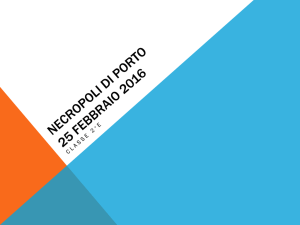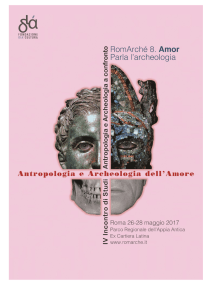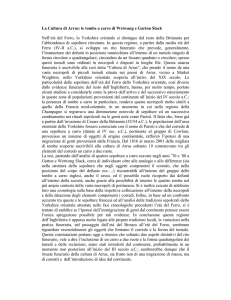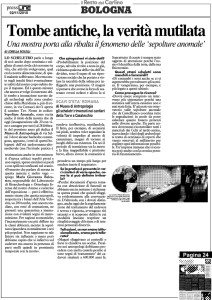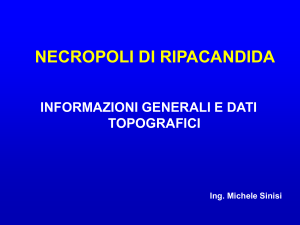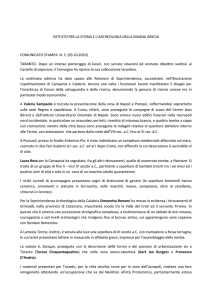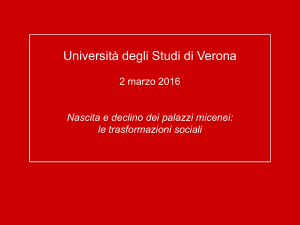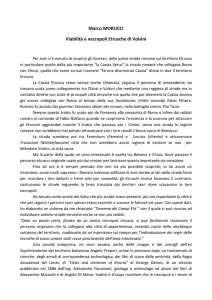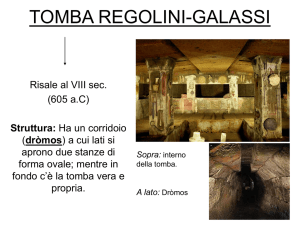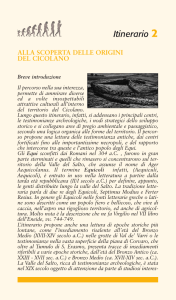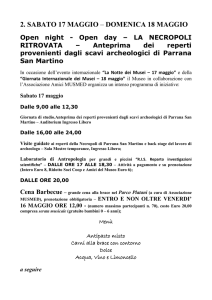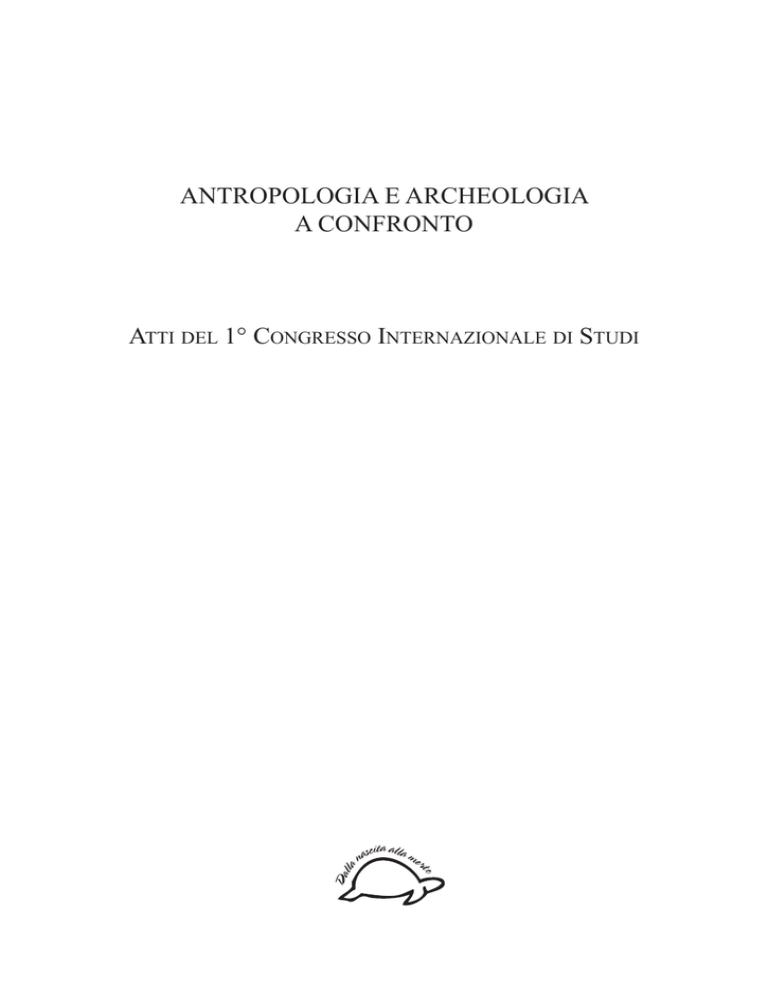
ANTROPOLOGIA E ARCHEOLOGIA
A CONFRONTO
Da
lla
ATTI DEL 1° CONGRESSO INTERNAZIONALE DI STUDI
scita alla m
na
or
te
DALLA NASCITA ALLA MORTE:
ANTROPOLOGIA E ARCHEOLOGIA
A CONFRONTO
Atti dell’Incontro Internazionale di studi in onore di
Claude Lévi-Strauss
ROMA, MUSEO NAZIONALE PREISTORICO ETNOGRAFICO “LUIGI PIGORINI”
21 MAGGIO 2010
A cura di
VALENTINO NIZZO
E.S.S.
EDITORIAL
SERVICE
SYSTEM S.r.l.
ROMA 2011
5
DALLA NASCITA ALLA MORTE: ANTROPOLOGIA E ARCHEOLOGIA A CONFRONTO
Atti dell’Incontro Internazionale di Studi in Onore di
Claude Lévi-Strauss
Proprietà riservata-All Rights Reserved
© COPYRIGHT 2011
Progetto Grafico
System Graphic Srl
Tutti i diritti riservati. Nessuna parte di questo libro può essere riprodotta o trasmessa in qualsiasi forma o con qualsiasi mezzo elettronico, meccanico o altro, senza l’autorizzazione scritta
dei proprietari dei diritti e dell’Editore.
All rights reserved. No part of this publication may be reproduced, stored in a retrieval system,
or transmitted in any form or by any means, electronic, mechanical, photocopying, recording
or otherwise, without the prior permission of the publishers.
IN COPERTINA:
Fotomontaggio: Apoxyomenos, Museo di Zagabria; Maschera Azteca a mosaico,
Museo Preistorico Etnografico “L. Pigorini” Roma; Scheletro umano; Porzione
di volto: gentile concessione Loris Del Viva. Ideazione ed elaborazione grafica:
VALENTINO NIZZO con la collaborazione di GIANFRANCO CALANDRA
PROGETTO SCIENTIFICO:
Valentino Nizzo (Soprintendenza Archeologica per l’Emilia Romagna)
Con la collaborazione di
Soprintendenza al Museo Nazionale Preistorico Etnografico “Luigi Pigorini”
Elisa Cella (Università del Salento)
COORDINAMENTO ORGANIZZATIVO E SEGRETERIA:
Valentino Nizzo, Elisa Cella, Simona Sanchirico, Laura Pasquali, EdiarchéEditoria per l’Archeologia Srl.
6
CASA EDITRICE:
E.S.S. Editorial Service System srl
Via di Torre Santa Anastasia 61-00134 Roma
Tel 06.710561 Fax 06.71056230
[email protected] www.editorial.it
DIRETTORE EDITORIALE:
Simona Sanchirico
REDAZIONE:
Simona Sanchirico, Valentino Nizzo, Elisa Cella
COLLANA:
Antropologia e Archeologia a confronto 1
DIRETTORE DI COLLANA:
Valentino Nizzo
Finito di stampare nel mese di maggio 2011
dalla tipografia System Graphic Srl
Via di Torre Santa Anastasia 61-00134 Roma
Tel 06.710561 Fax 06.71056230
[email protected] www.sysgraph.com
SOSTEGNO LOGISTICO:
System Graphic Srl - Tipolitografia Stampa Digitale
Ediarché - Editoria per l’Archeologia Srl
Via di Torre Santa Anastasia 61-00134 Roma
Tel 06.710561 Fax 06.71056230
www.ediarche.it [email protected]
di Luciano Pasquali
Dalla nascita alla morte: Antropologia e Archeologia a Confronto, Atti dell’Incontro
Internazionale di Studi in onore di Claude Lévi-Strauss [Atti del Congresso tenutosi a
Roma, Museo Preistorico Etnografico “Luigi Pigorini”, il 21 Maggio 2010] / a cura di
VALENTINO NIZZO. Roma: E.S.S. Editorial Service System, 2011, pp. 824.
ISBN 978-88-8444-114-0
CDD D.930.1
1. Archeologia – Antropologia Culturale – Antropologia Fisica – Atti di Congressi
2. Claude Lévi-Strauss – Atti di Congressi
I. Valentino Nizzo
7
INDICE
VALENTINO NIZZO, Premessa..................................................................p. 11
Programma del convegno......................................................................p. 19
Abbreviazioni e norme bibliografiche ...................................................p. 23
INTRODUZIONE DEI LAVORI
VALENTINO NIZZO, Introduzione ............................................................p. 27
STEFANO DE CARO, Apertura del Convegno ..........................................p. 41
LUIGI LA ROCCA, Il museo delle differenze culturali: radici per un
futuro del Museo “Pigorini” ..................................................................p. 45
I SESSIONE. NASCITA E INFANZIA
VALENTINO NIZZO, “Antenati bambini”. Visibilità e invisibilità dell’infanzia
nei sepolcreti dell’Italia tirrenica dalla prima età del Ferro all’Orientalizzante:
dalla discriminazione funeraria alla costruzione dell’identità................p. 51
CECILIA PENNACINI, Concezioni dell’infanzia nell’Africa dei
Grandi Laghi..........................................................................................p. 95
II SESSIONE. ADOLESCENZA
E RITI DI PASSAGGIO VERSO L’ETÀ
ADULTA
FRANÇOISE HÉLENE MASSA-PAIRAULT, Qualche considerazione sui
passaggi dell’adolescenza e i suoi paradigmi: dai boschi alla città .......p. 107
ALESSANDRO LUPO, Il rito e la costruzione sociale della persona..........p. 121
III SESSIONE. UNIVERSO
FEMMINILE . MADRI , MOGLI , REGINE ,
SACERDOTESSE
GILDA BARTOLONI, FEDERICA PITZALIS, Madri e mogli nella nascente
aristocrazia tirrenica...............................................................................p. 137
MASSIMO VIDALE, La visibilità della donna nelle stratigrafie
archeologiche: il corto circuito etnoarcheologico..................................p. 161
8
IV SESSIONE. UNIVERSO MASCHILE (GUERRIERI, PRINCIPI, SACERDOTI ED EROI)
ANNA DE SANTIS, L’ideologia del potere: le figure al vertice delle
comunità nel Lazio protostorico (con una Nota Antropologica a cura di
PAOLA CATALANO, FLAVIO DE ANGELIS, STEFANIA DI GIANNANTONIO) ..p. 171
FABIO VITI, I guerrieri degli Antichi e dei (Pre)Moderni (America, Africa) ..p. 199
DISCUSSIONE
VINCENZO PADIGLIONE, CECILIA PENNACINI, VALENTINO NIZZO,
PIERO GIOVANNI GUZZO ..........................................................................p. 233
V SESSIONE. ORIGINI DELLA COMPLESSITÀ SOCIALE
A) SVILUPPO DEI SISTEMI PROTO-URBANI E NASCITA DELLE CITTÀ
ANDREA CARDARELLI, L’origine delle comunità protourbane in Italia ..p. 247
MARIANO PAVANELLO, Modelli di insediamento e complessità sociale: la
tesi del “big bang” Akan e la transizione dalla caccia-raccolta all’agricoltura ..p. 259
B) EVOLUZIONE DEI SISTEMI DI PARENTELA E NASCITA DELLE ARISTOCRAZIE
EUGENIO BORTOLINI, MAURIZIO TOSI, Dal Kinship al Kinship: Le tombe
collettive nell’Oman del terzo millennio a.C. e la costruzione della
civiltà di Magan .....................................................................................p. 287
PATRIZIA RESTA, Il modello segmentario della nazione albanese, dai
lignaggi alle reti di parentela in una società agropastorale....................p. 319
VI SESSIONE. DONO E SCAMBIO: ALLE ORIGINI DEL COMMERCIO E
DEI SISTEMI DI SCAMBIO PRIMITIVI
NICOLA PARISE, CARMEN MARTINELLI, EMANUELA ALBERTI, Reciprocità
e ridistribuzione, modelli meccanici e modelli statistici .......................p. 345
FABIO DEI, Alla ricerca dello hau. Persone, cose, scambi......................p. 381
VII SESSIONE. MORTE. RITI DI PASSAGGIO,
TANATOMETAMORFOSI, PALEOPATOLOGIA
PROBLEMI LIMINALI,
ANNA MARIA BIETTI SESTIERI, Archeologia della morte fra età del bronzo
ed età del ferro in Italia. Implicazioni delle scelte relative alla sepoltura
in momenti di crisi o di trasformazione politico-organizzativa.............p. 397
HENRI DUDAY: L’Archéothanatologie et ses incidences sur la compréhension
des pratiques funéraires. Quelques applications relatives à des nécropoles
protohistoriques et historiques de l’Italie méridionale et de la Sicile....p. 419
9
LUCA BONDIOLI, ALESSANDRA SPERDUTI, Comunità dei morti e individui
scheletrici: dallo studio di popolazioni alla ricostruzione della storia
biologica individuale .............................................................................p. 431
ADRIANO FAVOLE, L’ambivalente statuto dei resti umani: il caso del
nuovo Museo Cesare Lombroso di Torino ............................................p. 461
CONCLUSIONI
MICHEL GRAS, Riflessioni conclusive....................................................p. 481
SESSIONE POSTER (A CURA DI E. CELLA)
ELISA CELLA, Antropologi e archeologi a confronto: il convegno on-line ..p. 487
NASCITA E INFANZIA
SONIA MODICA, Suoni dal silenzio eterno: idiofoni, aerofoni, oggetti
sonori e morti premature del Lazio antico.............................................p. 503
SILVIA AGLIETTI, La Mors Acerba. Alcuni spunti di riflessione sulla
sepoltura degli infanti in età romana .....................................................p. 517
ADOLESCENZA E RITI DI PASSAGGIO VERSO L’ETÀ ADULTA
IDA BRANCACCIO, Parthenoi dell’acropoli, salvezza della città.............p. 531
RACHELE DUBBINI, Lo spazio dell’aggregazione: choros e dromos nei
riti d’istituzione in Grecia......................................................................p. 545
ELENA FRANCHI, Riti di iniziazione in Grecia antica? un terreno
d’indagine interdisciplinare ...................................................................p. 553
VERA ZANONI, Nella terra di nessuno. Antropologia fisica e cultura
materiale nella giacitura del cacciatore della Busa Brodeghera ............p. 563
PIA GRASSIVARO GALLO, DEBORA MORO, ALESSIA PASSAQUIETI, Le
ragazze di Mangochi (Malawi) raccontano il longininfismo rituale
(genital stretching).................................................................................p. 575
UNIVERSO FEMMINILE. MADRI, MOGLI, REGINE, SACERDOTESSE
GIANLUCA MELANDRI, La donna e il potere a Capua tra ostentazione
suntuaria e ritualità funebre: il caso della t. Fornaci 722 di età orientalizzante...p. 591
SABRINA BATINO, Il mondo delle spezie e degli aromi: l’immaginario
dello zafferano .......................................................................................p. 613
SIMONA SANCHIRICO, La Pizia di Delfi. Metodi oracolari e rituali
catartici di contatto ................................................................................p. 629
ORIGINI DELLA COMPLESSITÀ SOCIALE: SVILUPPO DEI SISTEMI
PROTO-URBANI E NASCITA DELLE CITTÀ
MARIO FEDERICO ROLFO, FRANCESCO MESSINA, GABRIELE SCORRANO,
VALERIA TRUPIANO, AGOSTINA APPETECCHIA, Analisi genetica di comunità
montane in aree isolate del centro Italia tra preistoria e storia ..............p. 649
10
ORIGINI DELLA COMPLESSITÀ SOCIALE: EVOLUZIONE DEI SISTEMI DI PARENTELA E NASCITA DELLE ARISTOCRAZIE
MASSIMO OSANNA, MICHELE SCALICI, Nascita delle aristocrazie e
sistemi di parentela in area nord-lucana ................................................p. 669
GABRIELLA CETORELLI SCHIVO, Un singolare caso di social inclusion
nell’insediamento protostorico di Caracupa - Sermoneta (LT) .............p. 683
GIANCARLO GERMANÀ BOZZA, Necropoli e società aristocratica a Siracusa
durante l’età arcaica...............................................................................p. 689
DONO E SCAMBIO: ALLE ORIGINI DEL COMMERCIO E DEI SISTEMI DI SCAMBIO
PRIMITIVI
DANIELE F. MARAS, FERDINANDO SCIACCA, Ai confini dell’oralità. Le
forme e i documenti del dono nelle aristocrazie orientalizzanti etrusche ..p. 703
MORTE. RITI DI PASSAGGIO, PROBLEMI LIMINALI, TANATOMETAMORFOSI,
PALEOPATOLOGIA
MASSIMILIANO DI FAZIO, “La morte è dura; ancora più duro il cordoglio”.
Primi appunti da una indagine sul pianto rituale nel mondo etrusco.....p. 717
GIOVANNI DI STEFANO, GIUSI VENTURA, Una sepoltura principesca
nella necropoli greca di Castiglione: un “festino” per i morti e un
“banchetto” per i vivi.............................................................................p. 727
SABRINA MASOTTI, EMANUELA GUALDI-RUSSO, Il rito della cremazione:
osservazioni antropologiche su alcuni casi studio di particolare
interesse da necropoli dell’Italia settentrionale .....................................p. 735
AMEDEO BOROS, Una comunità rurale ungherese e il suo particolare
sistema funerario. Il rituale comunitario di Szatmárcseke come motore
di continuità culturale ............................................................................p. 747
ROBERTO LIBERA, Il ponte: un passaggio nell’Aldilà attraverso
l’indefinito .............................................................................................p. 759
BIBLIOGRAFIA RAGIONATA DI CLAUDE LÉVI-STRAUSS
ANNAMARIA FANTAUZZI, L’opera e l’eredità critica di Claude Lévi-Strauss.
Promemoria bio-bibliografico ...............................................................p. 771
ABSTRACTS E KEYWORDS
Relazioni ................................................................................................p. 809
Posters ...................................................................................................p. 817
SESSIONE POSTER
ORIGINI DELLA COMPLESSITÀ SOCIALE
EVOLUZIONE DEI SISTEMI DI PARENTELA E NASCITA
DELLE ARISTOCRAZIE
DALLA NASCITA ALLA MORTE
689
NECROPOLI E SOCIETÀ ARISTOCRATICA A SIRACUSA DURANTE
L’ETÀ ARCAICA
Il periodo che seguì la fondazione delle colonie greche in Sicilia vide definirsi
nuovi rapporti di identità e di diversità rispetto al mondo nativo anche attraverso
diverse simbologie. Tra questi aspetti vanno inserite le pratiche funerarie.
Lo studio del “mondo dei morti” come sistema strutturato è possibile solo nel
caso in cui una necropoli fornisca un insieme globale di informazioni, le quali
vanno lette nel loro insieme come testimonianza del quadro sociale di un particolare momento storico.
Allo stato attuale delle nostre conoscenze l’attenzione degli studiosi si è concentrata sullo studio dei modi di seppellimento che, nel caso di Siracusa, evidenzia sostanziali differenze con la madrepatria Corinto.
La necropoli in contrada Fusco
Le prime indagini archeologiche nella necropoli del Fusco (Fig. 1), avvenute
a più riprese durante la seconda metà del XIX secolo1, fornirono, oltre alla documentazione delle tipologie tombali e di corredi, nuovi dati relativi alla topografia delle aree sepolcrali. Per l’abbondanza di materiale furono studiati
le ceramiche di importazione e i grandi crateri a colonnette arcaici con decorazione geometrica dipinta di produzione locale2. Lo studio topografico della
necropoli permise di osservare un suo progressivo sviluppo verso ovest3 e di
individuarne il limite meridionale4.
Le tombe più antiche della necropoli del Fusco si datano alla fine dell’VIII sec.
a.C. e sono state localizzate nella zona adiacente la stazione ferroviaria. I riti funerari attestati prevedevano sia l’incinerazione primaria in ustrina e secondaria
in vasi e urne sia in bacili bronzei entro pozzetti circolari o quadrati. In età arcaica
sembra più attestata l’inumazione in fosse rettangolari tagliate nella roccia, talvolta contenenti sarcofagi litici, e coperte da lastre di pietra o tegole a spiovente.
Nel corso delle campagne di scavo furono documentati anche frammenti di
stelai con rilievi in calcare e in marmo, di cornici decorate e di edicolette5.
MAUCERI 1877; FIORELLI 1881.
ORSI 1895; ORSI 1897.
3
ORSI 1891; ORSI 1893.
4
ORSI 1894; ORSI 1895.
5
ORSI 1897; ORSI 1915.
1
2
690
GIANCARLO GERMANÀ BOZZA
Durante il secolo scorso altre campagne di scavo hanno riportato alla luce numerose tombe, fra le quali otto sepolture in sarcofago monolitico con corredi
ceramici del VII sec. a.C.6. Le tombe del tipo a inumazione all’interno di sarcofagi monolitici contenevano corredi costituiti da oggetti di ornamento personale e ceramiche.
Dagli scavi sono emerse anche sepolture del VI sec. a.C., prevalentemente del
tipo a inumazione in fossa di varia tipologia, con orientamento E-O. Queste
ultime, molto concentrate e talvolta sovrapposte, contenevano vari oggetti di
corredo databili all’inizio del VII sec. a.C.7
Anche all’interno dell’abitato moderno gli scavi archeologici hanno riportato
alla luce altre necropoli, alcune delle quali in uso già nel VII sec. a.C.
La necropoli di viale Santa Panagia
Indagini archeologiche più recenti hanno riportato alla luce un’altra necropoli
con tombe che si datano tra la fine del VI e l’inizio del V sec. a.C. tra viale
Santa Panagia e via Mazzanti (Fig. 2). Le numerose tombe, circa trecento, individuate nella necropoli sono per la maggior parte tombe a fossa, scavate
nella roccia calcarea (Fig. 3). Un primo dato che si rileva è la predominanza
nell’area in questione di questo tipo di sepoltura rispetto alle incinerazioni.
Un’altra considerazione è la presenza di sepolture a enchytrismos.
La generale uniformità delle sepolture, soprattutto nel settore centrale della
necropoli, non sembra far emergere alcun tipo di gerarchia sociale; solo una
tomba sembra indicare la deposizione di una persona di rango maggiore, forse
un mercante, per la monumentalità della fossa e per l’eccezionalità del corredo
consistente in due alabastra di marmo.
Nella necropoli si individuano casi di raggruppamento familiare, come mostra
una serie di tombe in cui si scopre il cadavere inumato di una donna e, accanto,
la fossa di un bambino. Le sepolture dei neonati forniscono informazioni in
merito al tasso di mortalità infantile che risulta non superiore al 19,79%.
I corredi funebri sono costituiti da ceramica di importazione e di produzione
locale; è, tuttavia, presente anche un buon numero di tombe prive di corredo,
alcune delle quali certamente oggetto di rimaneggiamenti in epoche successive.
Nel corso delle prime indagini archeologiche effettuate dall’Orsi nella necropoli del viale Santa Panagia, era stato rilevato che le tombe di bambini risultano avere un corredo più copioso rispetto a quello degli adulti maschi. Un
dato particolare è inoltre rappresentato da alcune sepolture di donne senza cor6
7
AGNELLO 1949.
BASILE 1993.
DALLA NASCITA ALLA MORTE
691
redo poste nel settore meridionale della necropoli, nei pressi di un probabile
edificio sacro.
La necropoli del viale Santa Panagia riveste una grande importanza anche
sotto il profilo topografico, in quanto si sviluppa ai lati di una strada, secondo
un sistema individuato anche in quella del Fusco.
La necropoli settentrionale di Corinto
Interessanti confronti sia per quanto riguarda la topografia delle necropoli sia
per le tipologie delle sepolture si possono osservare nella necropoli settentrionale di Corinto (Fig. 4). Il periodo di prosperità che portò Corinto a fondare
colonie in Occidente trova infatti un importante riflesso nelle tombe di questa
necropoli. Dall’analisi delle sepolture è stato possibile osservare l’assenza di
corredi “ricchi”, mentre nella maggior parte dei casi le tombe risultano prive
di offerte. Non sono attestati oggetti di importazione, sebbene la città in questo
periodo fosse stata particolarmente attiva sulle rotte commerciali.
Nei corredi della necropoli settentrionale di Corinto si è potuto anche osservare
che sono pochi i vasi dello stesso tipo e forma della ceramica protocorinzia
rinvenuta nelle tombe della Sicilia: questo perché le sepolture di Corinto sono
più antiche dei movimenti di colonizzazione e soprattutto perché la maggior
parte dei vasi nei corredi sono ampie forme aperte, come i crateri, che poco si
prestavano al trasporto. Sul mercato dovevano essere immesse soprattutto piccole forme vascolari che venivano apprezzate più per il loro contenuto che per
il loro valore intrinseco.
Nella maggior parte dei casi, inoltre, il corredo delle tombe risalenti all’VIII sec.
a.C. è stato sconvolto dalle sepolture che si installarono nelle fasi successive.
La maggior parte delle tombe risalenti al periodo geometrico rinvenute nella
necropoli settentrionale di Corinto è del tipo a cista, con alcuni esempi di sarcofago e urna usati per la deposizione di infanti. Sono assenti le cremazioni.
Solo un numero limitato di tombe a cista ha offerto un corredo riferibile al periodo geometrico, mentre nella maggior parte dei casi si trattava di sepolture
prive di corredo8.
Le tombe del periodo protocorinzio possono essere suddivise in maniera analoga
in base alla tipologia e all’orientamento, nonché alla posizione nella necropoli.
Nella maggior parte dei casi si tratta del tipo a sarcofago, con un orientamento
est-ovest o nord-sud, secondo un uso già attestato in età geometrica.
Il graduale passaggio dalla semplice tomba a fossa nella terra al sarcofago e
quindi al sarcofago realizzato con un solo blocco era già stata notata altrove.
8
BLEGEN, PALMER, YOUNG 1964, pp. 13-20.
692
GIANCARLO GERMANÀ BOZZA
Dal VII sec. a.C. il processo sembra ormai completo. La mancanza di vasi nei
corredi ha reso piuttosto difficile la datazione delle deposizioni.
In alcuni sarcofagi di tipo più antico è stata osservata la presenza di stucco
sulla superficie interna delle sepoltura. Si è trattato sicuramente di un sistema
per unire meglio le parti separate del sarcofago, che ancora non è realizzato
con un unico blocco lapideo. L’uso di stucco sulle superfici interne divenne
piuttosto comune nelle fasi più tarde della necropoli, fra il VI e il V sec. a.C.
Le tombe che hanno restituito un corredo presentano ceramiche di tipologie
semplici. Il gruppo più antico è costituito da vasi del medio protocorinzio,
dalle ceramiche di stile tardo protocorinzio e transizionale del terzo quarto del
VII sec. a.C.
Quello che appare strano è la totale assenza di vasi del tipo ampiamente attestato nelle necropoli occidentali, Cuma e Siracusa, in particolare nelle necropoli del Fusco.
Non sembra esserci stata una continuità, almeno per quanto riguarda la ceramica, fra le sepolture del periodo geometrico e quelle del periodo protocorinzio.
Il vuoto sembra riguardare l’antico protocorinzio. È possibile che per questo
periodo siano state utilizzate altre aree della necropoli non ancora indagate.
Le piccole forme vascolari dell’antico protocorinzio, comuni in Occidente,
come skyphoi e aryballoi, sono completamente assenti. Probabilmente i piccoli
vasi erano più adatti al commercio per il loro contenuto, preferibili a oinochoai
e crateri rinvenuti raramente nelle necropoli delle colonie e ampiamente attestati nelle necropoli locali.9
Sostanziali cambiamenti si registrano solo a partire dalla fine del VII sec. a.C.,
mentre le sepolture del VI sec. a.C. sono circa il doppio rispetto a quelle del
periodo precedente.
I riti funerari del periodo protocorinzio sembrano continuare senza soluzione
di continuità durante l’ultimo quarto del VII sec. a.C. e nel VI sec. a.C. Il tipo
di sepoltura predominante continua a essere l’inumazione. Le tombe adesso
sono orientate in senso nord-sud e est-ovest, ma al loro interno il corpo viene
collocato in modo tale che la testa risulti a est o sud. Alla fine del VII sec. a.C.
il corpo era collocato in una posizione contratta, ma dall’inizio del VI sec. a.C.
si trovano sepolture in posizione distesa, che divengono prevalenti dopo la
metà dello stesso secolo. Le braccia erano in genere poste ai lati del corpo,
ma in alcuni casi sono state incrociate sul torace. In alcuni casi probabilmente
fu collocato un supporto per la testa come testimonia il fatto che molti teschi
sono caduti in avanti.
9
BLEGEN, PALMER, YOUNG 1964, pp. 50-52.
DALLA NASCITA ALLA MORTE
693
L’età dell’inumato rimane difficile da determinare, mentre per il sesso si può
ricorrere a dei validi criteri, in particolare alla presenza di gioielli. In particolare, durante il VI secolo a.C., vengono usate regolarmente le fibule. La pisside, che in genere può indicare una sepoltura femminile, ha un significato
diverso: essa ricorre soprattutto nelle sepolture di infanti e comunque in tombe
con strigile. La conclusione è che la pisside era dedicata principalmente ai
bambini, sia maschi che femmine.
Tra il VI e la prima metà del V sec. a.C. le sepolture sono principalmente in
sarcofago. Le casse, di una tipologia già nota nel VII sec. a.C., sono realizzate
da blocchi unici in pietra tenera locale. Nelle fasi successive si perfeziona la
tecnica di lavorazione della pietra.
La maggior parte dei sarcofagi presenta tracce di stucco bianco o giallastro.
Lo stucco era stato utilizzato dal periodo protocorinzio, mentre durante l’antico
e medio corinzio veniva applicato solo sui sarcofagi più elaborati, ma a partire
dalla metà del VI sec. a.C. si trova sia sui sarcofagi più grandi che su quelli di
dimensioni minori.
Dalla fine del VI secolo a.C. sembra che i sarcofagi siano di due misure standardizzate. In questo modo è difficile capire se la mortalità degli adolescenti,
nella fascia compresa tra i cinque e i quindici anni, fosse piuttosto bassa o se
i loro corpi venissero collocati nei sarcofagi per gli adulti.
Le casse monolitiche erano utilizzate in molte necropoli della Grecia durante
l’età classica, ma in nessuna di esse era così comune come in quella di Corinto.
Questo si può spiegare con la grande disponibilità di pietra tenera, facilmente
lavorabile, che aveva la città.
Il loro uso preponderante può avere avuto anche un significato religioso, da
interpretarsi con la necessità di preservare il corpo per un periodo di tempo
più lungo possibile. Per questo il sarcofago veniva ulteriormente rifinito e sigillato con lo stucco.
La maggior parte dei contenitori rinvenuti nelle necropoli di Corinto contenevano resti di neonati. Il tipo di vaso utilizzato era il cratere o un’anfora. È attestato anche l’uso di ceramica da cucina, mentre la hydria, il cui uso era
frequente durante il periodo geometrico, non si trova dopo il VII sec. a.C.
Sembra che tutte le sepolture in contenitore di ceramica si possano datare
prima della metà del VI sec. a.C., anche se nella necropoli sono stati trovati
numerosi frammenti sporadici di crateri databili tra il tardo VI e il V sec. a.C.,
compreso un cratere a figure rosse. Non esiste ancora un sistema preciso per
determinare se si trattava di urne, di semplici offerte o di un tipo di segnacolo
della tomba.
Il numero limitato di urne, in contrapposizione ai numerosi sarcofagi, costi-
694
GIANCARLO GERMANÀ BOZZA
tuisce un dato importante sull’uso relativo del rito dell’enchytrismos.
Dall’inizio del V sec. a.C. è attestato l’uso, accanto alla cassa in pietra, di un
nuovo tipo di copertura dell’inumato fatto con tegole fittili. Quest’uso non si
affermò sul sarcofago e rimase limitato fino all’ultimo quarto del secolo.
Conclusioni
Nelle necropoli siracusane si possono osservare sostanziali differenze rispetto a
quelle di Corinto, pur attestando in generale una continuità di usi. In particolare
possiamo osservare la preponderanza dell’inumazione all’interno di sarcofagi e
fosse rettangolari scavate nella roccia, attestata in entrambe le città dalla fine
dell’VIII sec. a.C., e la compresenza di deposizioni di infanti e di adulti10.
Si possono osservare delle differenze rispetto ai riti della madrepatria anche
nelle pratiche crematorie, nell’uso diffuso della sepoltura a enchytrismos e nei
seppellimenti multipli11.
Uno degli indicatori più rilevanti dell’adozione di pratiche diverse rispetto alla
madrepatria è costituito dalla cremazione secondaria in un recipiente bronzeo.
Questa pratica risulta attestata a Siracusa dalla fine dell’VIII e per tutto il VII
e il VI sec. a.C.12.
I corredi sono generalmente costituiti da ceramiche di importazione, che probabilmente erano usate per la toletta del defunto e per la cerimonia funebre13.
Nella tomba Fusco 3 si può osservare come gli oggetti da toletta siano deposti
all’interno del lebete, mentre i vasi potori siano posti intorno ad esso14.
Le pratiche di cremazione secondaria entro lebete, nonostante la presenza di
varianti, trovano a Siracusa il collegamento con il modello omerico reso nella
descrizione dei funerali di Patroclo ed Ettore15, assumendo quindi il valore del
“modello” attraverso l’interpretazione delle élites aristocratiche locali.
COLDSTREAM 1977; PELAGATTI, VALLET 1980, pp. 355-396; SHEPHERD 1995, pp. 51-82.
SHEPHERD 1995, pp. 51-82.
12
Fine VIII – inizi VII sec. a.C.: tomba Fusco 219. VII sec. a.C., secondo quarto: tombe Fusco
221, 556; terzo quarto: tombe Fusco 465, 656; fine VII sec. a.C.: tombe Fusco 439, 712. VI
sec. a.C.: tombe Fusco 170, 616; prima metà: tombe Giardino Spagna XVII e XIX; secondo
quarto: tomba Isonzo 4; metà: tombe Fusco 551 e senza n.; terzo quarto: tombe Fusco 3, 515;
530-520 a.C.: tomba Giardino Spagna IV; fine VI sec. a.C.: tomba Villa Maria XIII. Al secondo quarto del VI secolo a.C. appartiene anche il corredo della tomba Fusco 2, tranne una
kylix a occhioni, deposta in un secondo momento nella tomba, forse in occasione di cerimonie
successive. Per la datazione delle tombe v. ALBANESE PROCELLI 2000, pp. 32-37, n. 13.
13
A proposito dell’uso secondario di anfore da tavola laconiche collocate per ultime nella
tomba 8 di Megara Hyblaea e Fusco 2 di Siracusa v. PELAGATTI 1992.
14
ALBANESE PROCELLI 2000, p. 32.
15
HOM. Il. 23.105 e segg.; HOM. Il. 24.791 e segg. Cfr. KURTZ, BOARDMAN 1971; VERNANT
1982, pp. 27-89; SCHNAPP-GOURBEILLON 1982, pp. 77-88.
10
11
DALLA NASCITA ALLA MORTE
695
Queste pratiche sono note in Grecia dalla metà dell’VIII sec. a.C. ed ebbero
un’ampia diffusione che portò ad adottarle fino a Cipro per le deposizioni di
guerrieri16. In Occidente le troviamo verso la fine dell’VIII sec. a.C. a Cuma,
dove le incinerazioni entro lebete venivano poste in una custodia litica.
A Siracusa, dove questo rito è attestato nella necropoli del Fusco e in quelle
rinvenute all’interno dell’abitato moderno, la scelta di cremare i defunti e di
porre le ceneri in un lebete bronzeo deve avere motivazioni di ordine sociale
e ideologico, nonché implicazioni relative alla classe e all’età del defunto17.
L’uso di un calderone a labbro rientrante per bollire le carni durante il banchetto funebre trova nella tomba Fusco 2 una importante conferma con il rinvenimento dell’impugnatura di un coltello di ferro fra le ossa di un
lebete-cinerario18. Nella necropoli settentrionale di Corinto, invece, solo le
tombe 262 – datata agli inizi del V sec. a.C. – e 236 presentano cremazioni
entro lebete bronzeo19.
Si tratta, comunque, di oggetti che possono avere molteplici significati simbolici. È rilevante in questo senso l’uso, soprattutto nel VI sec. a.C., di dinoi come
ossuari contenenti i resti delle cremazioni. Questi vasi riportano nei riti funerari
l’ideologia simposiaca caratteristica delle pratiche conviviali aristocratiche.
L’assenza di questi vasi nei corredi della necropoli di viale Santa Panagia potrebbe costituire un elemento importante per potere individuare in essa le sepolture del demos siracusano, che fra la fine del VI e il primo quarto del V sec.
a.C. si contrappose energicamente all’aristocrazia determinando prima la cacciata dei gamoroi e, successivamente, l’avvento della tirannia dei Dinomenidi.
GIANCARLO GERMANÀ BOZZA
Accademia di Belle Arti “R. Gagliardi” di Siracusa
[email protected]
BÉRARD 1970; COLDSTREAM 1977.
Resti di tessuto, forse lino, avvolgenti le ceneri, sono stati rinvenuti nelle tombe Fusco 2 e
213, come anche a Gela (bacino bronzeo a labbro perlato n. inv. 14575) e Agrigento (dinos
bronzeo n. inv. 29193). Un drappo purpureo doveva avvolgere le ossa in una hydria all’interno
della tomba 1131 di Camarina datata alla metà del V sec. a.C. (per quest’ultima v. ORSI 1990).
18
CAVALLARI 1887, p. 36.
19
BLEGEN, PALMER, YOUNG 1964.
16
17
696
GIANCARLO GERMANÀ BOZZA
BIBLIOGRAFIA
AGNELLO 1949: S. L. AGNELLO, nn. 1843 e 2363 in FastiA 4, 1949.
ALBANESE PROCELLI 2000: R. M. ALBANESE PROCELLI, “Necropoli e società
coloniali: pratiche funerarie ‘aristocratiche’ a Siracusa in età arcaica”,
in AA.VV., Damarato. Studi di antichità classica offerti a Paolo Pelagatti, Milano 2000, pp. 32-38.
BASILE 1993: B. BASILE, “Indagini nell’ambito delle necropoli siracusane”, in
Kokalos 39-40, 1993-1994, pp. 1315-1342.
BÉRARD 1970: C. BÉRARD, L’Héroon à la Porte l’Ouest, Eretria 3, Bern 1970.
BLEGEN, PALMER, YOUNG 1964: C. W. BLEGEN, H. PALMER, R. S. YOUNG,
Corinth XIII. The North Cemetery, Princeton 1964.
CAVALLARI 1887: F. S. CAVALLARI, Su alcuni vasi orientali con figure umane
rinvenuti a Siracusa e Megara Hyblaea, Palermo 1887.
COLDSTREAM 1977: J. N. COLDSTREAM, Geometric Greece, London 1977.
FIORELLI 1881: G. FIORELLI, “Siracusa”, in NSc 1881, pp. 97-98; 124-125;
198-201; 250; 436.
GUZZARDI 2003: L. GUZZARDI, “Siracusa tra VI e V secolo a.C.: la necropoli
di viale Santa Panagia”, in Kronos 18-19, 2003, pp. 39-72.
KURTZ, BOARDMAN 1971: D. C. KURTZ, J. BOARDMAN, Greek Burial Customs,
London 1971.
MAUCERI 1877: L. MAUCERI, “Relazione sulla necropoli del Fusco in Siracusa”, in Ann Inst, XLIX, 1877, pp. 37 - 58.
ORSI 1891: P. ORSI, “Siracusa. Nuove scoperte di antichità siracusane”, in NSc
1891, pp. 369-416.
ORSI 1893: P. ORSI, “Relazione sugli scavi eseguiti nella necropoli del Fusco
in Siracusa nel dicembre 1892 e gennaio 1893”, in NSc 1893, pp. 445486.
ORSI 1894: P. ORSI, “Siracusa. Nuove scoperte nella necropoli del Fusco”, in
NSc 1894, p. 152.
ORSI 1895: P. ORSI, “Gli scavi della necropoli del Fusco a Siracusa nel giugno,
novembre e dicembre 1893”, in NSc 1895, pp. 109-192.
ORSI 1897: P. ORSI, “Di alcune necropoli secondarie di Siracusa”, in NSc 1897,
pp. 471-504.
ORSI 1915: P. ORSI, “Siracusa”, in NSc 1915, pp. 175-208.
ORSI 1990: P. ORSI, “La necropoli di Passo Marinaro a Camarina. Campagne
di scavo 1904-1909. A cura di M. T. LANZA”, in MonAnt s. misc. 4,
Roma 1990.
OSANNA 1999: M. OSANNA, “Il Peloponneso”, in E. GRECO (a cura di), La città
DALLA NASCITA ALLA MORTE
697
greca antica. Istituzioni, società e forme urbane, Roma 1999, pp. 129160.
PELAGATTI 1990: P. PELAGATTI, “Ceramica laconica in Sicilia e Lipari”, in BdA
75, suppl. al n. 64, 1990, pp. 123-247
PELAGATTI, VALLET 1980: P. PELAGATTI, G. VALLET, “Le necropoli”, in E.
GABBA, G. VALLET (a cura di), La Sicilia antica 1, vol. 2, Napoli 1980,
pp. 357 - 388 (in particolare pp. 359 - 365).
SCHNAPP-GOURBEILLON 1982: A. SCHNAPP-GOURBEILLON, “Les funerailles de
Patrocle”, in G. GNOLI, J.-P. VERNANT (eds.), La mort, les morts dans
les societes anciennes, Cambridge 1982, pp. 77-88.
SHEPHERD 1995: G. SHEPHERD, “The Pride of Most Colonials: Burial and Religion in the Sicilian Colonies”, in ActaHyp 6, 1995, pp. 51-82.
VERNANT 1982: J. P. VERNANT, “Alla tavola degli uomini: mito di fondazione
del sacrificio in Esiodo”, in M. DETIENNE, J. P. VERNANT (a cura di),
La cucina del sacrificio in terra greca, Torino 1982, pp. 27-89.
698
GIANCARLO GERMANÀ BOZZA
Fig. 1. Dettaglio della carta di Siracusa con la posizione della necropoli di viale Santa Panagia (da
GUZZARDI 2003, p. 65, fig. 1).
Fig. 2. Carta topografica di Siracusa (illustrazione Autore).
DALLA NASCITA ALLA MORTE
699
Fig. 3. Tomba 65, pianta e sezione
(da GUZZARDI 2003, p. 72, fig. 8).
Fig. 4. Carta topografica di Corinto (da
OSANNA 1999, p. 143).
ABSTRACTS E KEYWORDS
DALLA NASCITA ALLA MORTE
809
RELAZIONI
VALENTINO NIZZO
“Antenati bambini”. Visibilità e invisibilità dell’infanzia nei sepolcreti
dell’Italia tirrenica dalla prima età del Ferro all’Orientalizzante: dalla
discriminazione funeraria alla costruzione dell’identità
The part of community affected more than others by a selective process that changes its
representativity, is the one composed of subjects deceased before having reached puberty,
especially children younger than 3-4 years.
The analysis of the funerary treatment of this large part of society (which could reach up to
50% of the population) can offer clues for the interpretation of the evolution of social systems
and, at the same time, ritual beliefs connected with these delicate phases of life preceding the
introduction of the individual in society. Towards the end of the Early Iron Age, the representativity of infants starts to increase: some individuals present attributes of a type and rang that
would qualify them as adults, to the point that the burial and the entire funerary ceremony
seem to constitute a ritual intended to grant to the deceased the “signs” of a social condition
that death has prevented them to reach. This new perspective forms part of a broader framework of cultural and economic changes that collide with the indigenous communities from
the middle of the eighth century BC on, and which are amply testified by the funerary evidence, of which some examples of Osteria dell’Osa, Veio, Pontecagnano and Pithekoussai
are presented here.
KEY-WORDS
Infanzia, discriminazione funeraria, identità, Veio, Osteria dell’Osa, Pontecagnano, Pithekoussai.
CECILIA PENNACINI
Concezioni dell’infanzia nell’Africa dei Grandi Laghi
In the Great Lakes region of Africa the idea of child was relevantly different from the one developed in the Western world. Infancy was understood as a partial fulfillment of the person,
whose spirit survived after death. During the colonial period traditional institutions devoted
to the development of the person – namely the extended family – was substituted by schools,
but a vacuum was created in the construction of human beings. In some cases the consequences of this change were dramatic, like in the phenomenon of child witchcraft and child
soldiers in Congo, and of child sacrifices of Uganda.
KEY-WORDS
Africa dei Grandi Laghi, infanzia, persona, spiriti, possessione spiritica.
810
ABSTRACTS E KEYWORDS
FRANÇOISE-HÉLÈNE MASSA-PAIRAULT
Qualche considerazione sui passaggi dell’adolescenza e i suoi paradigmi:
dai boschi alla città
How can we illustrate adolescents’ anthropological and religious status in the Latin and Etruscan
World? Two main examples are analysed in order to show the complex aspects of transition
towards maturity and adult age. The first one is referred to the case of Camilla in Vergil’s
Aeneid, an adolescent whose transition to adult age and normal destiny is denied. A Praenestine mirror of the V Century B. C. tells us a very similar story, unveiling an analogous religious
pattern, where Diana and the woods personify the “non-maturity” status.
The second example illustrates on the contrary a successful passage to maturity in presence
of Diana and Apollo: the Cantolle mirror shows the transitional moment of the Etruscan youth
under the guide of Heracles. They are the new class of Juvenes Herculanei.
The dialectic opposition between woods and city offers the religious and anthropological back
ground of the examined paradigms we have to replace too in their proper historical context.
KEY-WORDS
Camilla, Rex Nemorensis, Diana, Heracles, Juvenes Herculanei.
ALESSANDRO LUPO
Il rito e la costruzione sociale della persona
Many human societies confer the utmost importance to the process through which their
younger members acquire the cultural models shared by the group. Some of these models
shape their identity as persons, i.e. subjects with agency, capable of a conscious and responsible behaviour. Ritual actions accompanying this process sometimes leave permanent marks
on the bodies, thus exhibiting the status changes imposed by the community. A few ethnographic examples will be discussed, analyzing the different options employed in representing
the process that Marcel Mauss has called the person’s “moral career”.
KEY-WORDS
Riti di passaggio, plasmazione socio-culturale, agentività, persona.
GILDA BARTOLONI, FEDERICA PITZALIS
Mogli e madri nella nascente aristocrazia tirrenica
This paper aims different topics concerning the two main roles played by women, not only
during the antiquity, while affirming their gender identity: the wife and the mother, which
both are considered compatible with any assumption of social and religious responsibilities.
The analysis is based both on the examination of the iconographic and literary sources, and
mainly on the study of medium Tyrrhenian area female graves, dating between the 8th and the
7th century BC. This is a period of deep cultural foreign influences towards the Etruscan
civilization with the aristocracy spread out.
KEY-WORDS
Genere, donne, mogli, madri, Orientalizzante.
811
DALLA NASCITA ALLA MORTE
MASSIMO VIDALE
La visibilità della donna nelle stratigrafie archeologiche: il corto circuito
etnoarcheologico
Starting from a seminal paper written by Nicholas David in 1971, the article presents some
ideas on the actual weight of household activities in the formation of the archaeological record.
The focus is to which extent male activities and social functions are actually represented in
settlement sites where most of the technical processes are monitored to the economical reproduction of the household. As female domestic activities are constantly overlooked in archaeological reconstructions, ethnoarchaeology may create a peculiar short-circuit in archaeological
interpretation. This latter can be solved only by acknowledging female household tasks as the
most important type of craft production carried out in an extint social system.
KEY-WORDS
Archeologia del genere, femminismo, lavoro domestico, unità domestica, documentazione
archeologica.
ANNA DE SANTIS
L’ideologia del potere: le figure al vertice delle comunità nel Lazio protostorico
Recent research studies have highlighted the potential of the funerary ritual which was adopted
in ancient Latium during the FBA (Period I) for the identification of social identities and roles.
The funerary record consists of small groups of cremation burials, apparently exclusive to
those members of each community who were appointed the main vertical roles. These burials
are equipped with a highly formalized combination of miniature grave goods, almost invariably
comprising the isomorphic indicators of the two most important vertical roles: military/political
(the sword) and religious (knife, statuette, double shields). Their frequent association in the
same burial apparently indicates that single men were often appointed both political and religious leadership. This combination of elements may support the hypothesis that the latter
were the agents of the cultural change which took place in this period, possibly as a reaction
to the previous influence from Etruria, whose specific action consisted of the enhancement
and reinforcement of the local cultural/ethnic identity.
The ritual of Latial period I is still practiced in similar forms in the subsequent phases of the
Iron Age, in relation to individuals holding important vertical roles.
KEY-WORDS
Incinerazione; miniaturizzazione; ruolo politico-militare; ruolo religioso; identità etnica.
FABIO VITI
I guerrieri degli Antichi e dei (Pre)Moderni (America, Africa)
A comparison between ancient and primitive or pre-modern societies can be made basing not
only on formal resemblances and historical derivations, but also on descriptions in literature
of worlds far away which are the work of authors whose cultural background is marked by
ABSTRACTS E KEYWORDS
812
references to Classical Antiquity.
While the Native American warrior is portrayed as a tragic and lonely hero evoking those of
Ancient Mythology, the African warrior is rather placed within a political order that is able to
organize and manage the army in ways analogous to the ancient Romans.
KEY-WORDS
Guerra, Guerrieri, Antichità, America, Africa.
ANDREA CARDARELLI
L’origine delle comunità protourbane in Italia
In Italy, there have been two approaches to analyzing the developing way of the protourban
society. The first approach, which assumes a perspective based on a brief time-span, does not
ascribe significance to previous Late Bronze Age evidences. The second one, which assumes
a perspective based on a wider time-span, moves within a framework where economic and
social change are recognizable at least from the Middle Bronze Age (XVII BC) onwards. The
latter is used in this brief overview, in which the growth of the protourban community is analyzed
chiefly in the southern Etruria context.
KEY-WORDS
Italia, Etruria, Età del Bronzo, comunità.
MARIANO PAVANELLO
Modelli di insediamento e complessità sociale: il contributo dell’antropologia ecologica
Wilks assumes that a rapid transition from a foraging economy to a labor intensive agrarian
system characterized the history of the Akan people during the 16th century in the forest area
of present-day Ghana. This article challenges this assumption and shows, from an evolutionary
point of view and on the basis of a set of elements from the literature on foraging and swidden
societies, that such a transition is not possible in a span of one or two centuries. Moreover,
the Author analyses and criticizes the models elaborated by R.L. Carneiro on the correlation
between techno-economic systems and social complexity.
KEY-WORDS
Agricoltura, Akan, Caccia-raccolta, Carneiro (R. L.), Transizione (processi di).
EUGENIO BORTOLINI, MAURIZIO TOSI
Dal Kinship al Kinship: Le tombe collettive nell’Oman del terzo millennio
a.C. e la costruzione della civiltà di Magan
From the end of 4th millennium BC Eastern Arabia knew a rapid accretion of social complexity connected to the expansion of trade networks, at the outcome of Middle Holocene
adaptive strategies. However, contrary to other areas across South West Asia, neither state
DALLA NASCITA ALLA MORTE
813
nor urban centres developed in the region. Water management systems were built and the resulting oases and coastal plateaus were closely overlooked by hundreds of monumental collective burials. A novel approach is proposed to explain the socio-cultural evolution underlying
the formation of Magan by means of an architecture of tribal alliances testified by complex
funerary practices.
KEY-WORDS
Evoluzione Culturale; Complessità Sociale; Tombe Collettive; Età del Bronzo; Oman.
PATRIZIA RESTA
Il modello segmentario della nazione albanese, dai lignaggi alle reti di parentela in una società agropastorale
The essay describes the changes involving the segmentary lineage kinship system in Albania,
showing how the principle of segmentarity has played an active role in mediating the transition
to the contemporary social organization. The general objective is to demonstrate, on the basis
of proposed ethnography, that the lineage segments, in a conflict situation faced after the fall
of Socialism, have acted as a mobile group in which there was activated alliance networks
that, founded on the sibling solidarity, have organized their own leadership privileging the
situational fields rather than kinships ones.
KEY-WORDS
Lignaggi segmentari; Discendenza unilineare; Reti cognatiche; Albania; Trasformazioni.
NICOLA PARISE, CARMEN MARTINELLI, EMANUELA ALBERTI
Reciprocità e ridistribuzione, modelli meccanici e modelli statistici
Karl Polanyi’s models of economic institutional structure in different societies have been revised in a debate that began since the publication of his works. Here are discussed two samples, showing processes that configure more dynamic models (PARISE).
In the recent debate on Bronze Age Near Eastern and Aegean societies, Polanyi’s redistributive
model has been widely criticized and revised, in favor of a more articulated and multi-faced
perspective. Large social and economic sectors appear since the first formation of the centralized state to be substantially autonomous, being linked to the central power only indirectly.
This holds true both within the internal (primary and related productions and craft activities)
and the external (exchange and trade) economic spheres. Mycenaean trade has to be seen
within this complex framework: it is a phenomenon so widely attested in the archaeological
record as much substantially absent from the contemporary texts. While Near Eastern and
Aegean archives give almost no mention of the fact, the circulation of Mycenaean products
is widely documented, both in the Eastern and Central Mediterranean. The diffusion of Mycenaean decorated pottery (and of its contents) is especially important, reaching imposing proportions during the 14th and 13th centuries BCE, with correlated phenomena of delocalization,
imitation, hybridization and reverberation. Despite some hints of palatial involvement in the
phase of production, this wide range of Mediterranean evidences points to the existence of a
complex network of multiform trade relationships and economic partnerships, too variously
ABSTRACTS E KEYWORDS
814
organized to be forced exclusively within the official codes of directional exchange (ALBERTI).
Polanyian Port of Trade as first institutional place of commerce proper of society whose economy
is embedded, is a place created in a periphery region, on the coast or along rivers where trade
partners may meet avoiding cultural impact on the host society. Transactions are regulated by
agreements and organized through government controlled channels (administrated trade).
The model, established by empiric approach that covers a too large chronologic period and
different geographic areas, sometimes in a romantic view of pre-capitalist societies, produced
a too static framework. This approach explains the disagreement of ancient economy students
on interpreting archaeological and epigraphic data on nature, dynamics and implications of
trade activities in a Port of Trade. Anyway the idea is relevant, because it focus on the ‘contact
surfaces’ between cultures, through which a sort of “cultural osmosis” takes place. Epigraphic
documents show relevant changing dynamics in wood trade between the Reign of Macedonia
and Greek cities on the coast, traditionally related to the king figure and gift exchange
(MARTINELLI).
KEY-WORDS
Karl Polany, Ridistribuzione, Porti di traffico.
FABIO DEI
Alla ricerca dello hau. Persone, cose, scambi
Anthropological theories on the concept of “gift” have constantly grown since the publication
of Marcel Mauss’ celebrated essay (1924). In this paper, I discuss some recent trends on the
topic, starting from the problem of the hau – the maori spirit of the thing given which compels
the recipient to make a return. Harshly criticized by Lévi-Strauss in the ‘50s, the theory of
hau can nowadays open new perspectives on exchange, material culture and the relationship
between things and persons. In particular, I argue that the category of “inalienable possession”
is an intriguing field of dialogue between archaeology and cultural anthropology.
KEY-WORDS
Dono, hau, Marcel Mauss, cultura materiale, oggetti inalienabili.
ANNA MARIA BIETTI SESTIERI
Archeologia della morte fra età del bronzo ed età del ferro in Italia. Implicazioni delle scelte relative alla sepoltura in momenti di crisi o di trasformazione politico-organizzativa
Changes in funerary ritual in connection with organizational and socio-political transformation
in Late Bronze Age and Early Iron Age Italy.
A generalized change in ritual may often constitute a visible indication of crisis and transformation in the corresponding community. This paper takes into consideration the different, but
uniformly significant implications of the adoption of cremation, which took place in northern
and central Italy from the initial phase of the Recent Bronze Age (ca. XIV-XIII sec. BC). The
considered complexes include the cemetery of Olmo di Nogara (Verona), single cremation
815
DALLA NASCITA ALLA MORTE
tombs from the Marche (Early Iron Age), the small groups of ancient Latium cremation tombs
with miniature funerary outfits (Latial period I, Final Bronze Age). In all three cases, the
change in ritual appears to be in close connection with a crucial socio-political innovation:
the transition from shared to centralized political and religious power.
KEY-WORDS
Necropoli, contesto, rituale funerario, incinerazione, armi.
HENRI DUDAY
L’Archéothanatologie et ses incidences sur la compréhension des pratiques funéraires. Quelques applications relatives à des nécropoles protohistoriques et historiques de l’Italie méridionale et de la Sicile
The archaeothanatologic approach renewed the methods of burial archaeology. At Cumae,
taphonomic observations led a reconstruction of the Iron Age burial containers: U-section
coffins (hollow tree trunks?), with narrow sides and much thicker ends. At Megara Hyblaea
(Sicily), a Hellenistic grave stored the simultaneous deposition of six individuals probably
died a violent death and buried face down. In that regard, the Author emphasizes the wealth
of information that can be taken out by the old excavation reports.
KEY-WORDS
Archeologia funeraria, Archeotanatologia, bara monossile, sepolture multiple, tafonomia del
cadavere.
LUCA BONDIOLI, ALESSANDRA SPERDUTI
Comunità dei morti e individui scheletrici: dallo studio di popolazioni alla
ricostruzione della storia biologica individuale
Reconstructing patterns of life and death of ancient populations from their odonto-skeletal remains is a rather delicate, complex and, mostly, unattainable task. Nevertheless, the informative
value of bones and teeth as an alternative data source for historical studies has been increasingly
acknowledged. This kind of date are certainly more “talkative” when “handled”, in a combined
individual/population approach, and when interpreted in a broader, multidisciplinary-derived
frame.
This study demonstrates the value of a multidisciplinary approach which brings together
historical and paleoanthropological evidence.
KEY-WORDS
Paleobiologia, età romano imperiale; paleonutrizione; paleotraumatologia; esostosi del meato
acustico.
816
ABSTRACTS E KEYWORDS
ADRIANO FAVOLE
L’ambivalente statuto dei resti umani: il caso del nuovo Museo Cesare
Lombroso di Torino
The aim of this article is to reflect on the ambivalent status of human remains. Suspended
between being and nothingness, subject and object, person and thing, matter and meaning,
the human remains are frequently used as instruments of negotiation and political confrontation.
Beginning with reconstructing the debates on “repatriation” that have involved cultural anthropologists, physical anthropologists, archaeologists and museums in recent decades, this article
examines the controversies over the opening of the new Cesare Lombroso Museum in Turin.
The thesis argues that the presence of human remains, their inherent ambivalence, is an important source of conflict and ethnic polarization between “meriodionali” or “Borboni” and
“settentrionali” or “Sabaudi”.
KEY-WORDS
Resti umani, Museo Lombroso, Antropologia culturale, Antropologia fisica, Restituzione.
817
DALLA NASCITA ALLA MORTE
POSTERS
ELISA CELLA
Antropologi e archeologi a confronto: il convegno on-line
In the last decade a new way of communicating archaeology is taking place, due to the developing of the web and the diffusion of on-line journals and forum dedicated to anthropology
and archaeology. The meeting “Dalla nascita alla morte: antropologia e archeologia a confronto” has in the Poster and Forum on-line section some of his main peculiarities, both intended as tools for the improvement for an innovative way of dialogue between archaeologists
and anthropologists.
KEY-WORDS
Forum, antropologia, archeologia, comunicazione, Poster
SONIA MODICA
Suoni dal silenzio eterno: idiofoni, aerofoni, oggetti sonori e morti premature del Lazio antico
The well-known treatment of children remains provides another way to interpreting the evidence of the so-called ‘liminal rite’. Sounding objects of different mechanism and shape
(tintinnabula, whistles, wind chimes, castanets and so on) characterize several child burials
in the same way as some adult ones. Spaces, ritual behaviour and mortuary patterns are the
symbolic recall to special categories of deceased, maybe those mentioned with the definition
of ‘exsequiae immaturae’. Archaeological remains and ritual options suggest new readings
about the burial area setting connected to private choices, transmission of memory, tradition
perpetuation and gender ritual.
KEY-WORDS
Latium Vetus, protostoria, aerofoni, sepolture infantili, rituale.
SILVIA AGLIETTI
La Mors Acerba. Alcuni spunti di riflessione sulla sepoltura degli infanti
in età romana
The Roman literary sources, compared with the rare burials of the Imperial Age, show how
the infants, died before their first birthday, had no legal dignity. On the contrary, the rare epigraphic data testify the will of self-affirmation of the lower classes of society. In particular,
the inscriptions of cemeteries surrounding the castra Albana, the legionary camp built in the
3rd century AD, 20 km south of Rome, seem to be associated with the growth of a new local
community, from which the infants were not excluded.
818
ABSTRACTS E KEYWORDS
KEY-WORDS
Sepolture infantili, età imperiale, epigrafia, classi sociali, castra Albana.
IDA BRANCACCIO
Parthenoi dell’acropoli, salvezza della città
The myth and the cult of Hyakinthides can be considered as an interesting explanation of the
relationship between young women and urban civic context of Athens. Focal point is the salvation of social community, which can be in young women’s power, as long as they assure
polis survivorship by new generations birth. Basic element is the initiation ritual which allows
to overcome the individual “presence crisis” during the transition age from adolescence to
adult life. As a sociological theory of social existence, final aim is the integration of new
politai in Athenian citizenship.
KEY-WORDS
Polis, parthenoi, sacrificio, hyakinthides-erechtheides, salvezza.
RACHELE DUBBINI
Lo spazio dell’aggregazione: choros e dromos nei riti d’istituzione in Grecia
The comparison between the archeological remains in the agorai of Corinth and Argos and
the literary sources seems to confirm the primary role played by the agonistic structures in
the context of the rites of aggregation. Many scholars already studied the meaning of the initiation cycle and its phases, but only few of them worked on its spatial dimension. If the marginal period is generally spent outside the polis, the integration into the citizen body through
institution rites took the form of athletic tests and lyric competitions set in the city center,
under the gaze of the assembled community.
KEY-WORDS
Agoni rituali, iniziazione, riti di aggregazione, dromos, choros.
ELENA FRANCHI
Riti di iniziazione in Grecia antica? un terreno d’indagine interdisciplinare
Although there’s no evidence of tribal initiation rites in ancient Greece, scholars of different
branches studied this subject. Through the dialogue with archaeology, epigraphy and anthropology, as well as with other branches, ancient history has overcome the notion of “initiation
rites” to create those, at present more fashionable, of “civic rites” or “institution rites”; they
belong to a general process of anthropopoiesis that leads, through many rites, from the birth
to the death, from the inherent incompleteness of the anthropos to a minor one.
KEY-WORDS
Iniziazioni, riti di passaggio, anthropopoiesis, ephebeia, agogé.
DALLA NASCITA ALLA MORTE
819
VERA ZANONI
Nella terra di nessuno. Antropologia fisica e cultura materiale nella giacitura del cacciatore della Busa Brodeghera
In 1976 human skeletal remains were recovered from the deep fissure known as Busa
Brodeghera: the skeleton belonged to a young male, dead at the age of 19-20, who suffered
from several skeletal alterations, both congenital and traumatic.
The discrepancy between the skeletal age and the socio-cultural meaning of the metal objects
found together with the bones, i.e. a Certosa fibula, three bronze rings, an iron knife and a
belt-hook - which is a typical feature of non adult’s venetic graves - shows the difficulties of
ancient societies in depicting the “no man’s land” of adolescence.
KEY-WORDS
Brodeghera, riti, passaggio, adolescenza, liminalità.
PIA GRASSIVARO GALLO, DEBORA MORO, ALESSIA PASSAQUIETI
Le ragazze di Mangochi (Malawi) raccontano il longininfismo rituale (genital stretching)
In 2004, Padua’s Working Group on FGM organized a mission to Malawi (Mangoci district)
to analyze the pre-pubertal rites of passage (chiputu) within which the stretching of the labia
minora occurs. The psychological experiences of the rite were emphasized by the analysis of
the drawings and the comments on the rite made by 95 schoolgirls (mean age, 13.98). 50% of
the examined girls underwent genital stretching. The results highlighted two different groups
of subjects: those who adhere to and those who criticize and are somewhat opposed to traditional stretching.
KEY-WORDS
Malawi, riti di passaggio prepuberali, genital stretching, esperienze psicologiche, drawing
test.
GIANLUCA MELANDRI
La donna e il potere a Capua tra ostentazione suntuaria e ritualità funebre: il caso della t. Fornaci 722 di età orientalizzante
The item analyzes the richest tomb 722 of Capua, dated to the Orientalizing period. The grave
goods are prestigious and foreign objects are together with local stuff. The ritual is exceptional:
the cremation type is comparable with that known at Proto-attic Athens. It is possible to reconstruct the various stages of the funeral process through the analysis of the documentation.
However, the distinctive feature of the tomb is that this kind of ritual is reserved to a woman.
This leads to analyze, from an archaeological and anthropological point of view, the difficult
correlation between women and power in Capua.
KEY-WORDS
Donna, potere, Capua, cremazione, Orientalizzante
ABSTRACTS E KEYWORDS
820
SABRINA BATINO
Il mondo delle spezie e degli aromi: l’immaginario dello zafferano
The sphere of aromatic plants and spices is an intriguing field of research, a virtual bridge
not only for intercultural communication and networks among complementary disciplines,
but also between past and present.
It can contribute to promote a valorisation of modern saffron spice cultivations as a cultural
product, an important cultural heritage whose links reach back more than three millennia in
the late Bronze Age Mediterranean.
KEY-WORDS
Zafferano/croco, rituali di passaggio, alterità, giardino, Thera.
SIMONA SANCHIRICO
La Pizia di Delfi. Metodi oracolari e rituali catartici di contatto
The Ancient Greeks created many oracular centers where - according to earlier myths - the
god Apollo spoke to the people to predict their future.
The priests of Apollo were mostly men, but there was also a woman - called Pythia - to deliver
oracles: she was regarded as the unconscious instrument of a divine revelation. This peculiarity
has its origin in a pre-apollinean phase of the delphic sanctuary, when the shrine was dedicated
to Gea, the goddess of Earth.
The Pythia descended into the adyton and ascended her tripod seat, holding laurel leaves and
a dish of water from the Kassotis spring, into which she gazed.
Using various oracular methods, she announced to the supplicants the will of Apollo.
KEY-WORDS
Pizia, Gea, sacerdozio femminile, catarsi, metodi oracolari, Delfi.
MARIO FEDERICO ROLFO, FRANCESCO MESSINA, GABRIELE SCORRANO,
VALERIA TRUPIANO, AGOSTINA APPETECCHIA
Analisi genetica di comunità montane in aree isolate del centro Italia tra
preistoria e storia
The genetic variability in Italy is the result of population movements and invasions which
took place in both historical and prehistoric times. The aim of this study is to reconstruct the
genetic background of mountain communities between Lazio and Abruzzo (central Italy) and
to establish if the genetic pool held before Roman colonization. Preliminary results will be
compared with the ancient genetic data obtained from the prehistoric site (Mora Cavorso Cave
near Jenne) and from some necropolis of pre-roman age. For a correct interpretation of the
results it’s important to consider the cultural and archeological context of this area.
KEY-WORDS
DNA, genetica, comunità montane, Mora Cavorso Cave, Jenne.
821
DALLA NASCITA ALLA MORTE
MASSIMO OSANNA, MICHELE SCALICI
Nascita delle aristocrazie e sistemi di parentela in area nord-lucana
The NW Lucanian territory plays a fundamental role in understanding the development and
the construction of pre-roman societies in southern Italy. By the end of 7th century B.C. the
population of this area seems to have had a deeper and stronger contact with different Greek
groups of the coast. Many of these ancient Lucanian sites have been discovered and studied
in the last few years, such as Torre di Satriano, where a very important social and political
centre of 7th -6th cent. B.C. has been recently discovered thanks to the excavations. Recent
analysis in the Ruvo del Monte necropolis showed as well, in the same period, the prominent
role of ancestors’ memory in the construction process of local societies.
KEY-WORDS
Basilicata, potere, memoria, Torre di Satriano, Ruvo del Monte.
GABRIELLA CETORELLI SCHIVO
Un singolare caso di social inclusion nell’insediamento protostorico di Caracupa-Sermoneta (LT)
From antiquity to present day, when the model of being in good health is strongly followed
and proposed, disease has been commonly regarded as a phenomenon, if not to be removed
drastically, at least to be marginalized and hidden, or even to be ignored. In this perspective,
a discovery among the archaeological excavations at the necropolis of Monte CarbolinoCaracupa (Sermoneta), in the province of Latina, is offered as an interesting case of “social
inclusion” of the past. The investigation of the tomb 12 (8th – early 7th century BC.) has revealed the remains of a deceased suffering from serious genetic abnormalities, whose grave
goods and whose living conditions were optimal (thanks to the observation of a proper diet,
as shown by the paleopathological diagnosis). It shows, therefore, as in the context of the
local community the deceased was accepted and supported by forms of parental assistance.
KEY-WORDS
Patologico, sociale, integrazione, Caracupa-Sermoneta, Latium Vetus.
GIANCARLO GERMANÀ BOZZA
Necropoli e società aristocratica a Siracusa durante l’età arcaica
After the founding of Greek colonies in Sicily, new relationships of identity took place among
the native world. The study of Syracuse necropolis offers new data, that, compared to the
necropolis of the motherland Corinth, provide new important evidences about an overwhelmingly aristocratic society until the expulsion of gamoroi and the advent of tyranny.
KEY-WORDS
Sepoltura, Corinto, necropoli, Sicila, Siracusa.
822
ABSTRACTS E KEYWORDS
DANIELE F. MARAS, FERDINANDO SCIACCA
Ai confini dell’oralità. Le forme e i documenti del dono nelle aristocrazie
orientalizzanti etrusche
Among the different values which can be identified in the aristocratic gift-exchange system,
we can point out some cases to be referred to opening-gifts in the context of international relationships. That is the case of some gold and silver oriental bowls found in Etruscan and
Latin Orientalizing funerary contexts. Furthermore, analyzing Homeric tradition and epigraphic texts − specially those occurring on the bucchero kyathoi of the Caere-Vetulonia series
− the authors try to recognize the meaning of gift in some selected cases and to identify the
most ancient ceremony aspects of gift, including oral tradition, sometimes recorded by 7th
century inscriptions.
KEY-WORDS
Dono, principi etruschi, kyathoi Caere-Vetulonia, epica omerica, scrittura e oralità.
MASSIMILIANO DI FAZIO
“La morte è dura; ancora più duro il cordoglio”. Primi appunti da una
indagine sul pianto rituale nel mondo etrusco
This text is part of a wider research, whose main topic has been the investigation of ritual
mourning as one of the aspects of the Etruscan funerary customs. Primary aim of the research
has been the creation of a database of all the images of mourners and prothesis (the exposition
of the dead). All the data were compared with the current anthropological debate on the value
of mourning. Finally, images have been analysed with a perspective connected with the studies
of gesture.
KEY-WORDS
Lutto, morte, pianto, Etruschi, rituali.
GIOVANNI DI STEFANO, GIUSI VENTURA
Una sepoltura principesca nella necropoli greca di Castiglione: un “festino” per i morti e un “banchetto” per i vivi
During the digging campaign of 1999 in the necropolis of Castiglione emerged 14 tombs
which, for typology and funeral rites, can be assigned to the archaic Greek type; between
them, tomb 12 can be considered as a funeral complex and original area: it is circumscribed
by circular stone fence and distinguished by the other tombs through its use as a multiple burial, rich outfits and an anomalous deposition of eight skulls, without post cranial remains,
connectable to a complex ritual which has no comparison beneath other coeval necropolises.
KEY-WORDS
Sepoltura, crani, banchetto, Castiglione.
DALLA NASCITA ALLA MORTE
823
SABRINA MASOTTI, EMANUELA GUALDI RUSSO
Il rito della cremazione: osservazioni antropologiche su alcuni casi studio
di particolare interesse da necropoli dell’Italia settentrionale
Cremation is a funeral custom that consists in corpse burning on funeral pyre. From the
anthropological study of burned bones we can determine physical and pathological characteristics
of the deceased, in order to reconstruct the population lifestyle they belonged. This paper
describes some interesting case studies from two Italian burial contexts, the Ponte Nuovo
necropolis (Verona, 10th - 9th century B.C.) and the necropolis of Bologna Centrale railway
station (1st – 3rd century A.D.).
KEY-WORDS
Cremazione, ossa, frammentazione; età del Ferro, età romana, Ponte Nuovo (Verona), Bologna
Centrale.
AMEDEO BOROS
Una comunità rurale ungherese e il suo particolare sistema funerario. Il
rituale comunitario di Szatmárcseke come motore di continuità culturale
Every funeral is a separation rite, inside which, in some cultural context, the aggregation rites
hold a prominent position. This happened in the last century in the Calvinistic community of
Szatmárcseke, a village in the Northeast of Hungary, where we have studied the community
funeral rite. The Calvinistic people use a particular wooden grave symbol named csónakalakú
(in the shape of a boat), and the Calvinistic cemetery too presents several peculiarities. The
funeral rite had a strong community content, which defended the family of the deceased from
the solitude of the death.
KEY-WORDS
Antropologia culturale, rituali funerari, cultura ungherese, continuità culturale, simbolo tombale ligneo
ROBERTO LIBERA
Il ponte: un passaggio nell’Aldilà attraverso l’indefinito
The symbolism of the bridge is part of a vision of dangerous passage between two worlds,
often used in religious beliefs and traditions, as a metaphor for the transit of the soul in the
afterlife. In ancient Rome, the pontifex seems to have, in the etymology of his name, a particular relationship with this symbolism.
The bridge is a path that connects two different realities, as a magical and dangerous site. The
pontifex is the “medium” that may link with the afterlife, as the intermediary between the sacred and the profane.
KEY-WORDS
Ponte, pontefice, morte, anima, diavolo.

